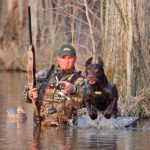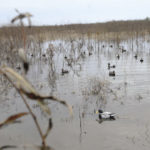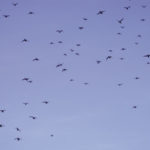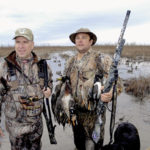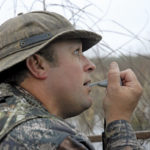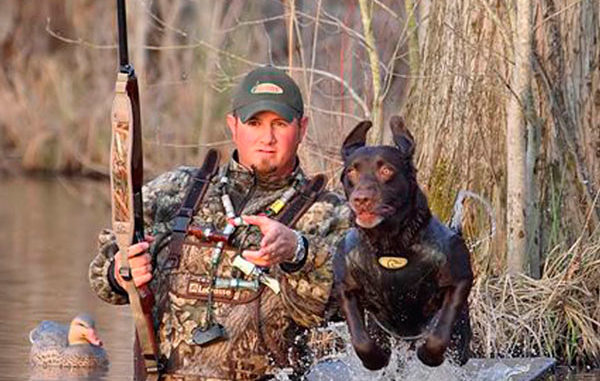
Incredible habitat draws ducks to this Central-Louisiana paradise.
I could hear the zooming wings of greenwing and bluewing teal just above my head as they glided into our decoy set. Mallards roamed the water, quacking away and the pintails whistled. This chorus of ducks talking reminded me of a church choir tuning up before a performance with all the singers checking their voices and chitchatting before the conductor took the stage.Finally, after what seemed an eternity, Drew Keeth whispered, “Take ‘em.”
Keeth and I stood in the blind, bringing our guns to our shoulders. At the same time, so many ducks came up in front of our blind that I had difficulty focusing on mallards and pintails with so many easy shots at teal, wigeons and gadwalls. Just about the time I’d pick out a duck I wanted to take, I’d spot another closer and easier-to-bag duck.
I looked like a shooting coach’s worst nightmare. As my cheek came up off the stock, I didn’t have my feet in a position to make an accurate shot, and I had my gun barrel nowhere near where it should be to pick up the lead and take the ducks.
However, when thousands of ducks come in volleys of from five to 20, from all directions, just trying to see the ducks spells mass confusion. What a dilemma you’ll have when you’re trying to pick the ducks you want to take out of a flock of more than 100 birds coming off the water.
I found my greenhead first. But as I swung to take that mallard, a gadwall flew in front of that bird, and the gadwall received the shot intended for the mallard. The teal had turned on their afterburners just as I prepared for my third shot, and I had no excuse for missing.
But Honey Brake had plenty of ducks on the water for the first round of shooting.
During the beginning of the 2009 Louisiana duck season, more than 50,000 ducks came to the 8,800 acres known as Honey Brake, a part of the 40,000-acre Louisiana Delta Plantation south of Jonesville. I witnessed there the best early season duck hunt I’d ever had in the United States. In two mornings, eight of us limited out on mallards, pintails, wigeons, ringnecks, redheads and teal.
The first morning, we finished hunting by 7:30 a.m. On the second morning, we decided to concentrate on mallards, pintails and wigeons, so we didn’t come out of the blind until 8:30.
During the late waterfowl season, more than 800,000 ducks frequented the Louisiana Delta Plantation, nestled between the Dewey Wills Wildlife Management Area, Larto Lake and Catahoula Lake, all famous for their duck hunting. The owners manage Honey Brake as a Wetland Restoration Program (WRP) designed by Ducks Unlimited for maximum population of ducks and shorebirds.
Every August, the landowners flood Honey Brake to create habitat for ducks, geese and shorebirds, and then pump off the water by April 15 each year. At one time, Louisiana Delta Plantation was second only to a large farm in Brazil for being the largest agricultural property in the world. Michael and Ron Johnson now hold this largest parcel of land from the original Louisiana Delta Plantation of years ago.
The Story of Honey Brake
The story of Honey Brake and its hunting is unbelievable, as are the lodge and the sleeping quarters. The lodge stands 11 feet above the floodplain of Larto Lake. Leaving from the lodge, guests can take a tree-lined tour of the area via a wooden walkway, also elevated 11-feet high, and from the lodge to all the out cabins built in the trees near the lodge. Instead of clearing land, the owners of Honey Brake have built the lodge and the out cabins up in the trees, a phenomenal sight to see and experience.
“A half-million trees have been planted in Honey Brake, and the property also has 4,000 acres of shallow-water impoundments designed by Ducks Unlimited for shorebirds and wintering waterfowl,” Keeth explains. “This entire 8,800 acres was in croplands before being pulled out of production and put into the WRP. The WRP requires that this property remain wetlands for waterfowl and shorebirds forever.
“We’ve built our lodge, cabins and walkways 11 feet above the floodplain to get electricity and other utilities. We want to make the experience much like a canopy tour you’ll find in the rain forest. After completion of the total project, we’ll be able to sleep and feed 42 hunters at a time.”
Unless you like to sleep a lot, I strongly recommend you enjoy a blast-and-cast adventure at Honey Brake. In a day at Honey Brake, a sportsman can enjoy a productive morning shooting ducks and also an outstanding day of fishing.
“We have guides available for crappie and bass fishing for any of our clients who want to fish Larto Lake,” Keeth said. “We also have the ability to offer a blast-and-cast opportunity to our hunters, especially at the first of duck season, when the temperatures still are often in the 50s, the 60s and the 70s. If we take our ducks by 7 a.m. or 8 a.m., anglers can fish the remainder of the day for bass or crappie.”
But waterfowl remains the main drawing card here.
“Each year, we start drawing water down in about April and take the water off Honey Brake very slowly,” Keeth said. “Using this slow draw-down procedure, we get different successions of natural grasses, shrubs and legumes that begin to sprout and grow as the water comes off the property.
“By the time we’ve got all the water off the land in June or July, Honey Brake is producing a tremendous crop of natural food for waterfowl. The ducks that remain here year-round move to Larto Lake after duck season and continue to feed on the agriculture we have on the farm.
“Then as we begin to bring the water up in the fall, they move back to Honey Brake to continue to feed on the agriculture. They also feed on the newly inundated grasses and shrubs that are now at water level or just under the water.”
At Honey Brake, clouds of ducks came up off the water like swarms of mosquitoes, and at times, ducks almost darkened the sky during the first week of the 2009 season. Generally, Louisiana didn’t have loads of ducks until late in the season, when cold weather froze up the lakes, rivers and croplands in the North.
“But we have a tremendous number of ducks year-round here at Honey Brake,” Keeth said. “The agriculture surrounding Honey Brake can feed a tremendous number of ducks and geese.”
On an early season duck hunt, if you’re hunting in the marshes, you’ll hope to have several good flights of ducks to try to work with a call and bring them into the decoys. However, at Honey Brake, you don’t have to worry about getting ducks in to the decoys, but rather what type of ducks you want to bring in to the decoys. You’ll see an extremely high number of ducks during the early season, and the variety of ducks will make duck hunters drool. I can’t remember an early season hunt when I’ve been so picky about the ducks I’ve tried to take that I’ve let teal, gadwalls, ringnecks and redheads pass within 40 yards of my blind or set their wings and drop into the decoys not 20 yards from the blind without my pulling the trigger.
However, on my Honey Brake hunt last year, not only did I not pull the trigger on these birds, I didn’t even come up above the blind to prepare to shoot. Since I really wanted to take pintails and mallards, the other ducks got get-out-of-jail-free cards when they dropped into our decoys.
Both mornings we hunted, I waited on the pintails, which I consider glamour ducks, to arrive.
“In 1993, wildlife biologists did a study to learn how often the pintails on Catahoula Lake flew to the saltwater marshes down in South Louisiana — about a 3- or 3 1/2-hour drive,” Keeth said. “The wildlife researchers found that the pintails here flew back and forth from Catahoula Lake to the saltwater marshes every night, and then returned to Catahoula Lake and stayed on the lake or came to the Louisiana Delta Plantation and remained there all day before flying back to the marshes the same day.
“Although we have a number of mallards, which seems to be the most popular duck for our hunters to take, we have a large number of hunters who come here just for the opportunity to take pintails.
“The pintails generally circle the blind more times before they commit to coming to the decoys than other ducks do. Oftentimes we have to let teal, mallards, wigeons and ringnecks land in the decoys before the pintails finally will come down.
“I use a Duck Commander pintail whistle to keep the birds’ attention and to get the pintails down and into the decoys. I usually give two to four calls in each sequence — soft calls when they’re coming toward the decoys. When they’re right on top of the blind, I speed up the calling and increase the volume just a little, and as they’re going away from me, I’ll whistle a little louder. I watch the pintails and respond with calling, depending on what they’re doing, and how they’re reacting to the call.”
To learn more about Honey Brake and Louisiana Delta Plantation, call (318) 339-7378.
